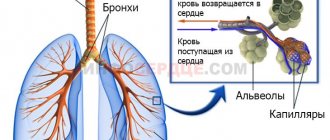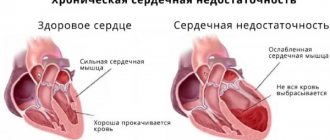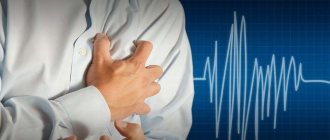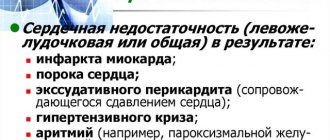0
Author of the article: Marina Dmitrievna
2017.12.18
9 770
Drugs
Cardioprotectors are used to prevent heart attack, stroke and other cardiovascular disorders. They help strengthen the heart muscle, accelerate cell regeneration processes and reduce the concentration of harmful substances in the body.
Heart
What are cardioprotectors?
Cardioprotectors are drugs that improve the functional and structural state of the heart muscle. Most drugs with cardioprotective properties either improve metabolic processes in the myocardium or reduce the load on the heart.
List of groups of drugs that improve heart function:
- Statin tablets;
- Beta blockers (or chondroprotectors);
- Antiplatelet agents.
Statins reduce the concentration of LDL, LDLNP and total cholesterol in the bloodstream. They modulate the synthesis and breakdown of LDL receptors and affect enzymes involved in cholesterol synthesis. Cholesterol is a lipophilic alcohol that is considered the leading cause of atherosclerosis.
Cholesterol
Adrenergic blockers are antagonists of adrenergic receptors. In medical practice, selective and non-selective beta antagonists are distinguished. By binding to the receptor, they interfere with the action of endogenous catecholamines: adrenaline, norepinephrine and dopamine. As a result, the refractory period of the AV node decreases, oxygen consumption by the myocardium decreases, and blood pressure drops.
Adrenergic receptors
Antiplatelet agents are drugs that “thin” the blood. They are used to prevent the formation of blood clots (thrombi) and plaques (atherosclerosis). Platelets play an important role in the human coagulation system. In case of severe bleeding, they can quickly clog the source of damage. However, an excessive concentration of platelets in the bloodstream “thickens” the blood and can cause the development of blood clots.
Attention! The drugs listed above are prescribed in combination or separately. In randomized trials, all three groups of medications demonstrated statistically significant reductions in mortality from vascular diseases.
There are other drugs that, however, do not have a clinically significant effect. List of names of drugs whose effect is comparable to placebo:
- Trimetazidine;
- Mildronate;
- Glycine.
Statins
Reducing blood lipid concentrations in patients after acute myocardial infarction (AMI) is of paramount importance in clinical practice. Rapid initiation of high-intensity statin therapy is strongly recommended for every post-AMI patient within 1 to 4 days of the cardiovascular event. The choice of type and dose should ensure a reduction in LDL cholesterol <70 mg/dL (less than 1.8 mmol/L) or at least 50%.
Health care professionals should be aware that LDL levels are assessed with caution in the acute phase after AMI because evidence suggests that lipid levels decrease after AMI. Therefore, it is recommended to repeat the analysis within 4-6 weeks after the vascular event.
Atherosclerosis
To achieve a reduction of >50% LDL, a dose of 40 or 80 mg atorvastatin or 20 mg or 40 mg rosuvastatin is recommended. The dosage is adjusted depending on the patient's LDL levels.
If target LDL levels are not achieved with the maximum available or tolerated dose of statin, the addition of ezetimibe (10 mg once daily) should be carefully considered as it is more effective.
HMG-CoA reductase inhibitors
By inhibiting the activity of HMG-CoA reductase in hepatocytes, statins reduce cholesterol synthesis in the liver, which leads to a decrease in intracellular cholesterol levels. This in turn causes upregulation of the LDL receptor on the surface of the hepatocyte, resulting in increased cholesterol uptake. The degree of action of statins depends on the dose and type of drug.
Important! Data from 26 randomized controlled trials (RCTs) show that a 40 mg/dL reduction in LDL cholesterol results in a 10% reduction in vascular events and a 20% reduction in mortality from acute coronary syndromes.
In secondary prevention, especially after AMI, the beneficial effects of statins are accompanied by potentially anti-inflammatory or anti-atherosclerotic effects.
PCSK-9 inhibitors
After uptake of low-density lipoprotein, PCSK-9 binds to intracellular LDL receptors, causing lysosomal degradation. Inhibition of PCSK-9 slows down the breakdown of LDL receptors, thereby increasing receptor expression on the hepatocyte. This leads to a decrease in the total concentration of LDL in the blood.
PCSK-9 inhibitors are administered subcutaneously every week or month. Efficacy in lowering LDL cholesterol is very high, with reductions of 50-70% reported regardless of background therapy. Randomized clinical trials also indicate that inhibitors are effective in the secondary prevention of myocardial infarction.
For atherosclerosis
Recommended doses of statins in the treatment of CHF
Such medications include:
- Statins. These drugs are the most effective among their relatives. These drugs have been used abroad for a very long time, however, it is worth noting that most of these drugs have a negative effect on the psycho-emotional state of patients. This mainly applies to female patients.
- Nicotinic acid is usually used in injections, and Nikoshpan is used exclusively in tablets. Joint use is often accompanied by a significant dilation of all peripheral vessels, as well as redness of the skin in the facial area.
- Colestipol and Cholestyramine are prescribed to increase the volume of fatty acids produced by bile.
- The use of fibrates is practiced, the most popular drug is Traykor.
In the presence of certain diseases of the cardiac system, medications such as:
- Anti-inflammatory.
- Immunocorrective.
- Thromboletic.
Almost all drugs are completely destroyed in the liver. The remains are excreted by the kidneys and intestines. Therefore, it is always very important to be sure that all systems and organs of the body are working as expected.
Beta blockers
Beta blockers counteract the effects of beta-adrenergic stimulants. Beta blockers reduce heart rate, cardiac contractility, and systolic blood pressure. They also have antiarrhythmic effects, since they reduce spontaneous excitation in cardiomyocytes, conductivity and increase the refractory period of the atrioventricular (AV) node.
Beta blockers are divided into non-selective (blocking both β1 and β2 receptors) and cardioselective β1 antagonists.
Beta blockers reduce mortality and the number of recurrent heart attacks by 20-25% in patients. Oral beta blocker treatment should be considered in all patients with myocardial infarction unless contraindicated. They are also indicated for left ventricular dysfunction and myocardial failure (MF).
Beta blockers are very effective drugs for the symptomatic treatment, alone or in combination with other drugs, for most patients with classic angina.
Beta blockers or calcium channel blockers are first-line medications for controlling heart rate and anginal symptoms.
Heart failure
Beta blockers have been shown to reduce mortality and heart failure in patients with reduced LV ejection fraction.
Adrenergic receptor blockers are recommended, in addition to ACE inhibitors, for the treatment of patients with stable symptomatic MR.
Bisoprolol, carvedilol, metoprolol and nebivolol are licensed for use in MR and are considered first-line drugs.
Arrhythmia
Beta blockers may be used to slow the heart rate in patients with arrhythmias such as atrial flutter or atrial fibrillation.
They are effective in controlling ventricular arrhythmias associated with sympathetic activation, acute coronary syndrome and heart failure. Adrenergic blockers are used to prevent sudden coronary death.
For arrhythmia and tachycardia
Heart medications for tachycardia are prescribed especially carefully, having previously examined the patient and identified possible contraindications. Every specialist knows that disturbances in heart rhythm exist of different origins, so the drug is always prescribed taking into account certain features of the malfunction.
There is simply no single drug for treatment. Moreover, if a person has experienced blockades of various origins and levels, then one must be especially careful with the drugs used, since some of them can only strengthen them.
If the extrasystole of the heart is weakly expressed, then the use of magnesium and potassium will be effective. Both of these substances have a close relationship, since they support the entire contraction mechanism in the muscles of the organ.
These two substances in the required dosage are contained in drugs such as Asparkam and Panangin. Both drugs are often used as preventative agents. The main difference between these medications is that Panangin is covered with an upper shell, while Asparkam is not. Therefore, some part of the consumed dose dissolves in the gastrointestinal tract.
If a tachyarrhythmic form is noted, then the use of adrenergic blockers is recommended to reduce the heart rate.
The most popular heart medications for cardiac arrhythmia include:
- Anaprilin.
- Obzidan.
- Propranolol.
- Ritmilen.
In the presence of obstructive diseases of the respiratory system, the following drugs can be used:
- Vasocardin.
- Betalok.
- Atenolol.
- Nebivolol.
- Acebutalol.
- Metoprolol.
If there are individual indications, the use of a cardiac glycoside such as Digitoxin is recommended.
Speed of action of cardiac glycosides
If there is a need to block the source of sudden overexcitation in cases of atrial fibrillation, in this situation most cardiologists recommend using:
- Procainomide.
- Quinidine.
- Novocainomide.
- Norpace.
- Ritmilen.
- Lidocaine.
- Xylocaine.
- Rhythmonorm.
- Ethacizin.
- Ethmozin.
- Propanorm.
- Bronnecore.
List of heart blocker drugs:
- Cordaron.
- Bretylium.
- Amiodarone.
- Tedisamil.
- Nibentan.
- Ibutilide.
Heart blockers are usually designed to fully restore contractile power in the myocardium:
- Isoptin.
- Cardil.
- Verapamil.
- Finoptin.
- Diltiazem.
- Gallopamil.
As therapy for blockade and pronounced bradycardia of the heart, it is recommended:
- Atropine.
- Ephedrine.
- Eufillin.
- Izadrin.
Antiplatelet agents
Platelets play an important role in the pathogenesis of atherosclerosis, therefore antiplatelet agents are used to prevent the development of this disease. The need for these drugs, especially in the secondary prevention of recurrent cardiovascular events, is supported by several studies that have assessed their effectiveness and safety. In primary prevention, the potential benefit of preventive use of acetylsalicylic acid (ASA) should be carefully assessed by the treating physician.
Aspirin
Advances in understanding the mechanisms by which platelets participate in atherosclerotic processes have led to the search for new drugs that can consistently inhibit platelet activity with maximum safety.
Different platelet receptors are activated by different agonists and serve as targets for thrombolytics, which have been evaluated in large randomized clinical trials.
Acetylsalicylic acid
The beneficial effects of ASA (cyclooxygenase inhibitor) appear to occur at a dose of at least 75 mg per day. The risk of bleeding increases with aspirin and appears to be at doses above 100 mg. Bleeding with ASA most often occurs from the stomach and with an incidence of ≈2% per year.
Biochemical tolerance to ASA rarely occurs in patients. For patients who have an allergic reaction to aspirin, a desensitization strategy may help relieve symptoms within a few days.
P2Y12 inhibitors
Given the synergistic importance of adenosine diphosphate and thromboxane in platelet activation, dual antiplatelet therapy with a P2Y 12 inhibitor in combination with aspirin is the most widely used treatment strategy in post-infarction patients. Currently available oral P2Y 12 receptor blockers are thienopyridines (clopidogrel, prasugrel) and ticagrelor.
Thienopyridines are taken orally. Most of these drugs are prodrugs that require metabolic activation by cytochrome P450. Thiolactone is an active metabolite of thienopyridines that irreversibly prevents ADP receptor-induced signaling and platelet aggregation by binding to the ADP receptor P2Y12. Ticagrelor does not interfere with ADP binding to P2Y12, but instead reversibly inhibits ADP receptor conformational change and G protein activation.
Ticagrelor has a rapid onset of action, higher level of inhibition and efficacy compared to clopidogrel.
Vorapaxar
Vorapaxar is a synthetic tricyclic 3-phenylpyridine obtained from natural gimbacin. It is the first high-affinity selective thrombin receptor antagonist that selectively inhibits thrombin-induced platelet aggregation. Its antiplatelet effect is practically irreversible due to its very slow dissociation constant.
What is the effectiveness of the above drugs for ischemic heart disease?
As mentioned above, atherosclerosis is an important risk factor for the development of coronary heart disease (CHD). Doctors recommend at least four pharmacological treatments to reduce the risk of adverse cardiac events in this group of patients: thrombolytic drugs, beta-blockers, HMG-CoA reductase inhibitors, and angiotensin-converting enzyme inhibitors.
IHD
Preliminary research suggests that patients stop taking cardioprotective heart muscle-strengthening medications at some point, thereby losing many of the benefits. In one study, only 21% of patients with CAD were sequentially taking a combination of aspirin, beta-blockers, and lipid-lowering agents. Additionally, another study found that only 36% of patients with CAD were still taking statins 2 years after being prescribed by their primary care physician. However, prior studies have not assessed the association between compliance with cardioprotective medications and mortality among patients with CAD.
The new studies aimed to evaluate the relationship between cardioprotective medications (eg, angiotensin-converting enzyme inhibitors, β-blockers, and HMG-CoA reductase antagonists) and treatment outcomes among patients with CAD.
The researchers assessed the association between receipt of one or more cardioprotective drugs and mortality in a population. The relationship between the regularity of taking medications and patient mortality was also assessed. The results of this study may have important implications for identifying treatment gaps for patients with CAD.
A retrospective cohort study of patients with coronary artery disease was conducted. Cardioprotective medication use and adherence to treatment were assessed during the 2003 calendar year. The results range from January 1, 2004 to April 30, 2005, which was the most recent date on which the relevant data were available.
The diagnosis of coronary heart disease was based on ICD-10 (International Classification of Diseases, 10th Revision) codes. The researchers included patients diagnosed with acute myocardial infarction also based on ICD-10 codes. These criteria have been found to be highly specific for CAD. Based on the above criteria, 3,998 patients were identified.
Heart attack
Patient demographics, comorbidities, vital signs, and laboratory data were obtained from KPCO automated databases.
Important! Clinical trials have demonstrated the effectiveness of drugs such as β-blockers, ACE inhibitors and statins. However, the effectiveness of combinations of these drugs remains less pronounced among patients with chronic CAD.
Previous studies have shown that mortality among patients at high risk of CAD who were prescribed combinations of cardioprotective drugs was much lower than in the control group. However, among patients with CAD, only 11% of patients received a combination of antiplatelet agents, ACE inhibitors and statins. In the study, 78.6% of patients received 2 or more drugs, and 38.7% took 3 cardioprotectors simultaneously.
ACE inhibitor
Patients receiving any cardioprotective drugs had lower mortality compared with patients not receiving any drugs. The results demonstrate the effectiveness of combinations of cardioprotectors and are consistent with recommendations that patients with CAD should receive all of these treatments unless contraindicated.
Who are heart medications indicated for?
In order for treatment to be effective, it must be started as quickly as possible. It is important to diagnose the disease at an early stage, so if you have the first symptoms, consult a doctor. First of all, you need to know the causes of such diseases and avoid them in everyday life.
The very first factors that provoke the development of heart disease are:
- Depression and excessive consumption of coffee drinks;
- Alcohol and smoking;
- Congenital diseases;
- Consequences of syphilis;
- The presence of viruses in the body;
- Atherosclerosis;
- Bacterial disorder in the human body;
- Obesity;
- Large amounts of salt in food;
- Lack of physical activity.
The increase in the number of heart patients also occurs due to unfavorable external conditions for human life.
These include:
- presence of factories and manufacturing enterprises in cities,
- environmental degradation,
- unsuitable climate and difficult working conditions,
- low standard of living and others.
The combination of the above factors significantly increases the risk of heart problems.
One of the most common causes of vascular diseases is their blockage. Normal blood circulation within the vessels is impaired as a result of clots blocking bottlenecks in the vessels.
A similar blockage can be created by atherosclerotic plaques that have been torn off from large arteries in the neck or by vascular spasms over a long period of time.
ATTENTION! Consultation with a cardiologist is necessary if you experience:
- Pain in the heart and sternum that occurs during exercise and disappears when the exercise stops;
- Irregular rate of heart contractions (arrhythmia);
- High pressure (more than 140/90 mm);
- Swelling of the legs;
- Very fast pulse, over 100 beats per minute;
- Heart rate less than 50 times per minute;
- Shortness of breath and cough during increased exertion or while resting on the back;
- Age 35 years and above.










